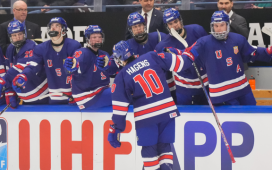There’s a contract you might be expecting to land on this list that you won’t find below. OK, truth be told, there are probably several, but that’s the nature of the beast when you’re trying to distill a decade’s worth of bad front-office decisions down to the 10 worst. For instance, you won’t find David Backes’ deal with the Boston Bruins below. You also won’t find Zach Parise’s contract with the Minnesota Wild on this list, either.
The one that was most difficult to leave off the list, however, wasn’t either of those deals. It wasn’t even any of the litany of contracts that have been signed in recent years that have backfired in one way or another. No, it was a deal signed less than 10 months into the 2010s: Ilya Kovalchuk’s 15-year, $100-million contract with the New Jersey Devils.
You see, for several reasons, the deal is deserving of mention. It was the clearest example of a cap-circumventing contract the league had seen to that point, it was a pact that followed the NHL straight-up rejecting the first effort between the Devils and Kovalchuk to get a deal done and it was a signing that neither party had interest in seeing through to the end. So much so that it was almost laughable. But here’s the thing: had it worked, and had Kovalchuk remained in the NHL, the years when he was at his peak probably wouldn’t have been so bad. And at $6.66-million per season, the cap hit was actually palatable.
Does that make the deal wholly defensible? Not in the least. It might actually appear below, too, if the Devils didn’t end up wriggling free from the contract by way of Kovalchuk’s voluntary retirement. Add to it Kovalchuk’s efforts in New Jersey – 89 goals and 201 points in 222 games and a post-season in which he helped guide the Devils to the Stanley Cup final – and he and the Devils are excused from landing on this list, if only barely.
With that out of the way, here are the 10 worst signings of the past decade:
10. Vadim Shipachyov – Two-year, $9-million contract (May 4, 2017)
The only reason this one isn’t higher is because the Golden Knights managed to get free of the deal before it could become a burden. There was palpable excitement about the signing, even around these parts, but what had potential to be a clever addition of a second-line center turned into an unmitigated headache by the time Vegas’ inaugural season rolled around. Shipachyov didn’t want to report to the AHL, was eventually suspended by Vegas, returned to Russia and eventually voluntarily retired from the NHL having played only three games with the expansion Golden Knights. He did score a goal, though, so there’s that.
9. Christian Ehrhoff – 10-year, $40-million contract (July 1, 2011)
This contract came around the time when the long-term, front-loaded, back-diving deals were en vogue, but those deals were mostly reserved for the creme de la creme, top-tier players who needed to be swayed by such deals. Ehrhoff didn’t strike anyone as that type of player, despite three consecutive 40-plus point efforts and two top-10 Norris Trophy finishes. Alas, the Buffalo Sabres threw a 10-year deal at his feet. The end result? Ehrhoff played 192 games with the Sabres, scored 87 points, earned $22-million and was bought out three years into the contract. Oof.
8. Karl Alzner – Five-year, $23.125-million contract (July 1, 2017)
Canadiens fans were worried about this one before the ink was even dry, and not without reason. Alzner was never a big point producer and spending nearly $5-million per season on a shutdown rearguard was a sizeable risk, particularly when that shutdown defender had played some awfully hard minutes throughout his roughly 650 combined regular season and playoff games. And there’s really no two ways about it now. The deal has landed with a thud. Montreal demoted Alzner to the AHL last season and he hasn’t seen a minute of NHL ice time in 2019-20. He still has two more seasons left on his contract. He’ll also be owed a $1.5-million bonus next season on top of possessing a limited no-trade clause.
7. Andrew Ladd – Seven-year, $38.5-million contract (July 1, 2016)
While a consistent 20-goal scorer and a consummate leader, Ladd was never a top producer in the NHL. Yet, when he hit the open market ahead of his age 31 season, the Islanders saw fit to throw a seven-year pact at the veteran winger. That deal has backfired tremendously. In no season in New York has Ladd, who hadn’t scored fewer than 38 points in the eight campaigns prior, exceeded 31 points, and the wear and tear on his body has limited him to 27 games over the past two seasons. He’s currently in the AHL and has the remainder of this season and three more campaigns left on his contract.
6. Loui Eriksson – Six-year, $36-million contract (July 1, 2016)
Surely, Vancouver Canucks fans will argue this is too low on this list. And, hey, argue away. Eriksson was signed to be a top-six fixture, but the only place he’s been able to consistently fit into the lineup has been on the third and fourth lines. What’s more is that Eriksson, who signed the whopping deal after a 30-goal, 63-point season, has only narrowly exceeded those points totals across the past four combined campaigns in Vancouver. He has 34 goals and 78 points in 216 games as a Canuck. Most will be surprised if he’s not bought out this coming off-season.
5. Ilya Bryzgalov – Nine-year, $41.88-million contract (June 23, 2011)
The Flyers’ goaltending woes are well-documented. So, when Philadelphia threw a boatload of cash at free agent netminder Ilya Bryzgalov, who was fresh off of consecutive top-six Vezina Trophy finishes with the Coyotes, most assumed it wouldn’t end well. Hardly anyone expected Bryzgalov to flame out in Philadelphia so spectacularly, though. In goalie-friendly Phoenix, ‘Bryz’ had posted excellent numbers, but his numbers were ugly with the Flyers without the same system in front of him. Across two seasons, he mustered a .905 save percentage, 2.60 goals-against average and 52-33-10 record. With seven years left on the deal and more than $25 million still to be paid out, the Flyers bought out Bryzgalov. They will continue paying him little more than $1.64-million per season until 2026-27 as a result of the compliance buyout.
4. Brent Seabrook – Eight-year, $55-million contract (Sept. 26, 2015)
The prevailing belief now, maybe more than ever, is that you pay players for what they will accomplish, not what they have in the past. That’s why we’re seeing more big-money deals for restricted free agents. Well, the Blackhawks could have used that kind of thinking before they went and handed Seabrook an eight-year deal that carries a nearly $7-million annual price tag. Seabrook was paid handsomely for what he had done in helping Chicago to three Stanley Cups, not what he would do in the future, and the Blackhawks are paying dearly for it now. Seabrook has lost a step, finds himself sidelined for the rest of this season and potentially a significant portion of next and he still has more than half the contract to go. Add in the no-movement and limited no-trade clauses over the next four seasons and you’ve got yourself a dud of a deal.
3. David Clarkson – Seven-year, $36.75-million contract (July 5, 2013)
Surely Leafs Nation knew this one would make the cut. The Clarkson signing was one of the more reactionary deals of the salary cap era, a response to two quality seasons in an otherwise mediocre career to that point. It was a bad deal from the outset, and Clarkson’s on-ice performance did little to change that belief. In 118 games with the Maple Leafs, he scored 15 goals and 26 points and averaged less than 14 minutes per game in his second season. Less than two campaigns into the deal, he was traded to the Columbus Blue Jackets. Speaking of which…
2. Nathan Horton – Seven-year, $37.1-million contract (July 5, 2013)
Originally, this deal was slotted as the fourth-worst, but after some consideration, it had to be bumped up two spots. That’s for a few reasons. First, due to injury, Horton had not played more than 50 regular season games in a single campaign at any point in the two seasons prior to signing a seven-year contract that had a $5.3-million cap hit. That’s a remarkable gamble. Second, he only managed to play a total of 36 games for the Blue Jackets after he put pen to paper on the deal. Thus, he didn’t really have any tangible impact in Columbus. And third, the contract wasn’t insured, which put Columbus on the hook once Horton was sidelined indefinitely. This led to the Blue Jackets willingly swapping the deal for David Clarkson’s in one of the most stunning trades of the cap era. When you have to take on an all-time bad contract because of your own all-time bad contract, that says something.
1. Ville Leino – Six-year, $27-million contract (July 1, 2011)
What in the world were the Buffalo Sabres thinking? Yes, Leino had authored two successful playoff performances and was coming off of a 19-goal, 53-point performance one season earlier, but he had just completed his age 27 season and had one campaign of 60-plus games under his belt. Somehow, though, the Sabres saw fit to throw $4.5-million per season at Leino over a six-year term. But we all know how this story ends. He managed 25 points in his first season in Buffalo, then appeared in only eight games during the lockout-shortened season and had a disastrous 2013-14 season in which he failed to score and registered 15 assists in the 58 appearances he made. He was bought out following that season and has since retired. This marks the last of six seasons in which the Sabres have paid him just north of $1.2 million as part of his compliance buyout.
Over the next two weeks, The Hockey News will be wrapping up the 2010s with a look back at the best – and worst – of the decade. Find more here.
Want more in-depth features, analysis and an All-Access pass to the latest content? Subscribe to The Hockey News magazine.








